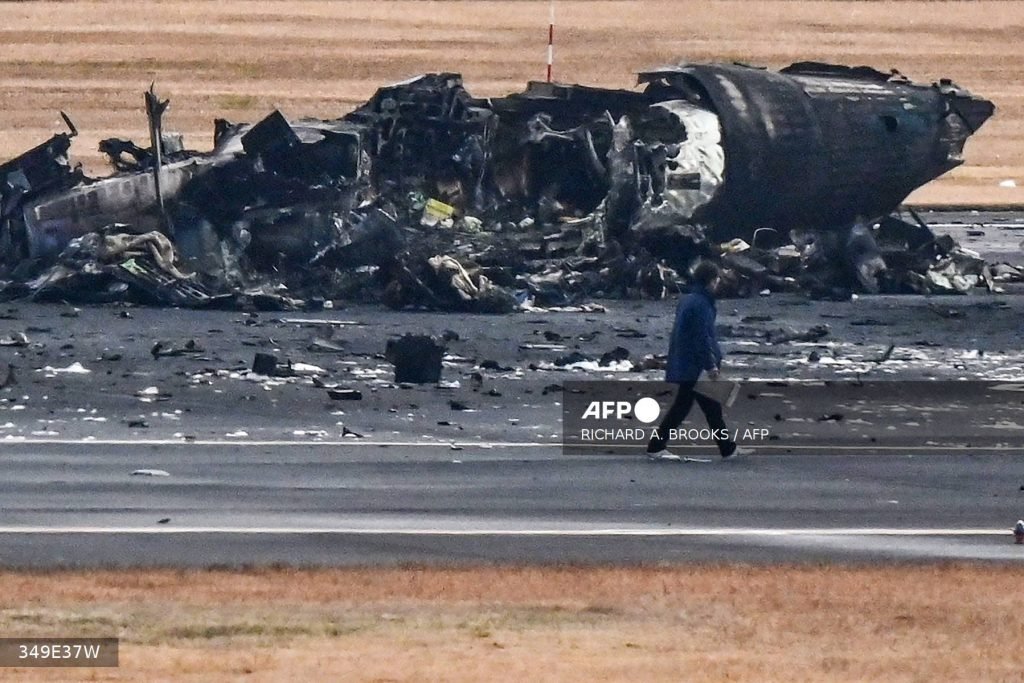How Japanese aircraft collision claimed five lives

Five people perished after a coast guard jet was hit by a Japan Airlines Airbus A350 going in to land, but all 379 people on board were evacuated.
The following is a summary of what is known following the January 2 crash at Tokyo’s Haneda Airport, which resulted in both planes engulfed in flames.
– Timeline of events
According to a communications transcript given by the Japanese government, air traffic control approved Japan Airlines aircraft JAL-516 arriving from Hokkaido to land on runway 34R at 5:44:56 pm.
On the tarmac, coast guard flight JA722A was told 15 seconds later to “taxi to holding point C5”, which was at least 50 meters (164 feet) from the runway’s edge.
The pilot of JA722A quickly recognized the order.
The Japan Airlines flight landed and collided with the coast guard’s DHC-8 aircraft around two minutes later, implying that the latter had flown onto the actual runway.
According to NHK, JA722A captain Genki Miyamoto, the lone survivor, confirmed immediately after the crash that he had clearance to take off.
According to an airline spokeswoman, the JAL flight crew had no “visual contact” with the other plane, however one of them observed “an object” just before collision.
– A black box
The investigators had yet to make their findings public.
The Coast Guard plane’s flight recorder and voice recorder have been recovered, as has the passenger jet’s flight recorder – but not its voice recorder.
“(We) must wait for the thorough accident investigation to be completed in order to know exactly what happened,” Griffith University aviation specialist Guido Carim Junior told AFP.
“In general, accidents like this one are always the result of multiple factors that influence each other and cannot be reduced to either human error or technology malfunction,” he went on to say.
– A ball of fire
As the JAL plane rushed down the runway, an orange ball of fire and black smoke burst beneath it. In the video footage of the incident, the coast guard jet is difficult to see.
Passengers’ video showed flames beneath the plane and smoke filling the cabin as babies screamed and adults yelled for the doors to be opened.
Related Stories
According to NHK, the nine flight attendants on board need permission to open the emergency doors, and their chief informed the cockpit of the fire to obtain that authorization.
– Exit –
According to international standards, aircraft should be able to be fully evacuated in 90 seconds utilizing half of the emergency exits.
There were eight emergency exits in this scenario, but only three – two in the front and one in the back left – could be used due to the fire.
The cockpit could not give authorization for the rear escape to be used since the intercom system was no longer operational, according to the airline.
The guests needed to disembark from the back door, so the personnel in the back opened it nevertheless, as they are instructed to do.
– Last man standing –
The 12-person crew guided all 367 passengers off the plane using emergency slides using megaphones and their unassisted voices.
The entire plane was evacuated in 18 minutes, with the pilot being the last person to set foot on the tarmac at 6:05 p.m.
Only two people were injured.
Soon later, the entire aircraft was ablaze, and scores of fire engines were battling the blaze. That process took eight hours in total.
– abandoned –
Experts said it was surprising that the passengers appeared to have left their things, including at least one pet dog and one cat, on the plane.
“Passengers seemed to have followed instructions in a textbook manner,” Terence Fan, an airline industry expert from Singapore Management University told AFP.
“This is exactly what evacuation policies are designed for – the airframe itself is not meant to survive the blaze, ultimately.”
AFP
